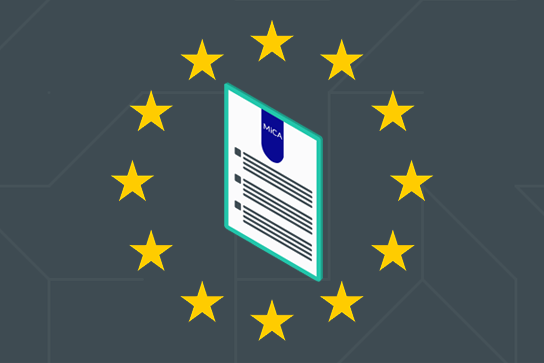
Stablecoins Are No More: MiCA’s EMTs and ARTs Explained
The European Union’s (EU) Market in Crypto Asset Regulation (MiCA) will apply to any person or entity providing crypto asset services, for example, crypto exchanges and all crypto assets that are not already subject to the EU regulation.
Unlike the Financial Action Task Force’s (FATF’s) Recommendations, MiCA does not tackle anti-money laundering (AML) risks, but it was designed to align EU legislation with the FATF’s Recommendations. This includes the terminology and scope of the regulations to a certain degree.
According to MiCA’s Consideration 8:
“Any legislation adopted in the field of crypto assets should be specific, future-proof and be able to keep pace with innovation and technological developments. ‘Crypto assets’ and ‘distributed ledger technology should therefore be defined as widely as possible to capture all types of crypto assets which currently fall outside the scope of Union legislation on financial services.”
In line with Consideration 8, MiCA has provided specific definitions for Electronic Money Tokens (EMTs) and Asset-referenced Tokens (ARTs), traditionally referred to as stablecoins. Additionally, as MiCA has laid down clear explanations, EMTs and ARTs are now governed by its rules and regulations.
Under MiCA’s framework, the terms stablecoin and Asset-backed Token (ABT) will have no legal meaning in the EU as they fall under different frameworks.
Stablecoins Are No More: MiCA’s EMTs and ARTs Explained
What Is a Stablecoin?
A stablecoin is a cryptographic asset pegged to another underlying asset (reserve) to maintain a stable value. The pegged asset is usually fiat currencies such as the Euro or US Dollar and does not need to match the asset that the stablecoin refers to.
ABTs also fall under the stablecoin category, but its value is pegged to a physical asset like oil or gold.
What Is An EMT?
An electronic money token (EMT) is a cryptographic token used for exchange and is pegged to a single fiat currency. The biggest difference from an asset-referenced token is that it can only be pegged to one fiat currency, for example, Tether or USDC.
As per MiCA, EMTs are to be backed by tangible world assets. E.g. if an issuer issues EUR 100 000 of a Euro-pegged EMT, the issuer would need to have EUR 100 000 (or assets denominated in EUR) stored somewhere, i.e. in a vault or bank account.
Like Electronic Money, which holds a one-to-one equivalence, EMTs operate similarly but are based on distributed ledger technology.
EMTs that reference EU currencies will have no limits on usage. EMTs pegged to non-EU currencies will see their limits capped at EUR 1 million.
With the implementation of the MiCA framework, EMT issuers and providers will be subject to further obligations, such as:
The European Banking Authority (EBA) will supervise and regulate all EMTs.
EMT issuers will need an E-money license (falling under the Electronic Money Directive) and a MiCA license to be legally allowed to issue EMTs.
What Is An ART?
An asset-referenced token (ART) is a cryptographic token used for exchange. However, its value can be pegged to more than one fiat, physical asset, cryptocurrency, or a mixture of all three, as seen with PAX Gold, DIAM or the ill-fated Libra Coin from Facebook.
ARTs are stablecoins in the sense that they try to peg themselves to the value of a defined basket of assets. For example, Libra tracked the value of a basket of fiats. The value of 1 Libra was determined by the following values: 50% United States dollar, 18% Euro, 14% Japanese yen, 11% Pound sterling and 7% Singapore dollar.
ARTs that reference EU currencies will have no limits on usage. ARTs pegged to non-EU currencies will see their limits capped at EUR 200 million.
With the implementation of the MiCA framework, ART issuers and providers will be subject to further obligations, such as:
All ARTs will be supervised by the European Markets and Securities Authority (ESMA) unless deemed “significant." In this instance, the EBA will take over.
Only token issuers with a registered office in the EU will be allowed to issue ARTs. This registration includes proper supervision and monitoring of offers to the public of ARTs.
ARTs not pegged to a European currency will be controlled to preserve the EU’s monetary dominance.
What Does It Mean for an ART to Be Significant?
According to the EBA, for an ART to be considered “significant”, 3 of the following 5 criteria need to be met:
The size of the issuer or providers’ customer base - does it exceed 2 million users?
The total value of the tokens issued - does it exceed EUR 1 billion?
The number of daily transactions - does it exceed more than 500 000 transactions per day?
The value of daily transactions - does it exceed more than EUR 100 million?
Is the issuer’s token offering available in more than 7 EU member states?
Once deemed significant, ART issuance will be supervised under an increased set of standards by the EBA.
Why the Need for EMTs and ARTs?
Firstly, owing to recent global events surrounding stablecoins, lawmakers noticed a lack of regulations to safeguard stablecoin users. This prompted EU lawmakers to include stablecoins as well as ABTs under MiCA.
Secondly, the EU and its 27 member states realised the key role stablecoins play in the crypto ecosystem - with or without EU influence; there will be innovation within this field. By creating its own regulations, the EU can better control the issuing and trading power these coins yield, as seen above in the capping on non-EU based EMTs and ARTs.



